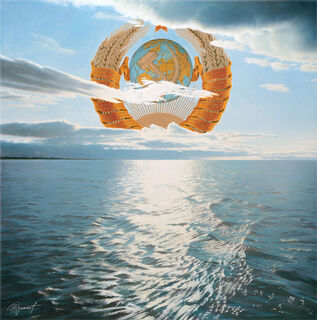Erik Bulatov
Art means freedom.
The Russian painter Erik Bulatov found himself in complete artistic isolation in the Soviet Union. He was separated from every Western development in contemporary art due to the Iron Curtain. Even at home, interactions with critics and the public was impossible, as Bulatov refused to be co-opted into the state-prescribed art canon and thus did not officially exist. In this intellectual vacuum, Bulatov, who earned his living as a children's book illustrator, developed his imagery, critically processing Socialist Realism as well as Russian Constructivism.
In order to create an opportunity for oppositional artists to present their work, Bulatov, together with colleagues such as Ilya Kabakov and Oleg Vassiliev, co-founded the "Sretensky Boulevard Group" in the 1960s, from which the artist group "Moscow Conceptualists" later emerged. But again, the governmental regulations of the Soviet art system interfered: In 1965, one of the first exhibitions he took part in Moscow was closed and banned after only one hour. Because of this experience, Bulatov emphasised the liberating power of art: "It has always been my conviction that the sphere of society has limits and that the path to freedom only leads through the sphere of art, which lies beyond these limits. Certainly, I know that this is not the universal path - but for me, it has always been the only possible one."
Erik Bulatov was born in 1933 in Sverdlovsk/Ural. He studied at the Moscow Art School and the Surikov Art Institute in Moscow, where he graduated in 1958. Erik Bulatov is one of the most important contemporary artists in Russia today. In 2008, he became an honorary member of the Russian Academy of Art. He lives and works in Paris. He has had solo exhibitions, among others, at the Musée des Beaux-Arts de la Ville de Paris, the Centre Pompidou, the Tretyakov Gallery in Moscow, and the Kestnergesellschaft in Hanover.

